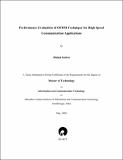Please use this identifier to cite or link to this item:
http://drsr.daiict.ac.in//handle/123456789/91| Title: | Performance evaluation of OFDM technique for high speed communication applications |
| Authors: | Maskara, S. L. Kabra, Mukul |
| Keywords: | Communication network High speed communication OFDM |
| Issue Date: | 2005 |
| Publisher: | Dhirubhai Ambani Institute of Information and Communication Technology |
| Citation: | Kabra, Mukul (2005). Performance evaluation of OFDM technique for high speed communication applications. Dhirubhai Ambani Institute of Information and Communication Technology, xi, 98 p. (Acc.No: T00054) |
| Abstract: | The Internet revolution has created the need for wireless technologies that can deliver data at high speeds in a spectrally efficient manner. However, supporting such high data rates with sufficient robustness to radio channel impairments requires careful selection of modulation techniques. The demand for high-speed mobile wireless communications is rapidly growing. OFDM technology promises to be a key technique for achieving the high data capacity and spectral efficiency requirements for wireless communication systems of the near future. Orthogonal frequency division multiplexing (OFDM) is a special case of multi-carrier transmission, where a single data stream is transmitted over a number of lower rate sub-carriers. OFDM is currently being used in Europe for digital audio and video broadcasting. The IEEE standardization group decided to select OFDM as the basis for their new 5-GHz standard, targeting a range of data stream from 6 up to 54 Mbps. This standard was the first one to use OFDM in packet-based communications, while the use of OFDM until now was limited to continuous transmission systems. OFDM is also being considered as a serious candidate for fourth generation cellular systems. In this project, transmitter, channel and receiver were simulated with various parameters, to evaluate the performance and different possibilities in the implementation. Also, some considerations about forward error correction coding, interleaving, synchronization and channel estimation are given to improve the system performance. |
| URI: | http://drsr.daiict.ac.in/handle/123456789/91 |
| Appears in Collections: | M Tech Dissertations |
Files in This Item:
| File | Description | Size | Format | |
|---|---|---|---|---|
| 200311034.pdf Restricted Access | 3.63 MB | Adobe PDF |  View/Open Request a copy |
Items in DSpace are protected by copyright, with all rights reserved, unless otherwise indicated.
